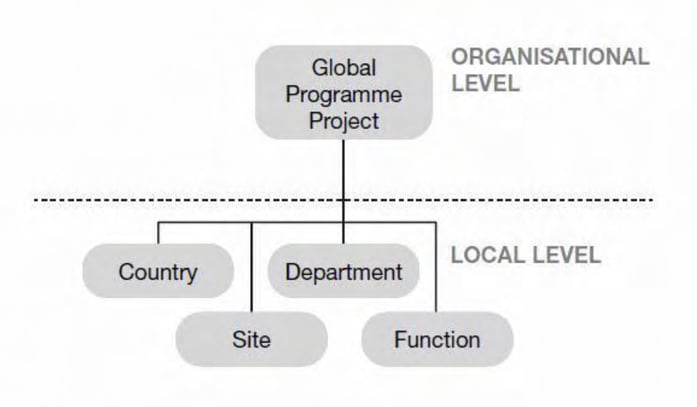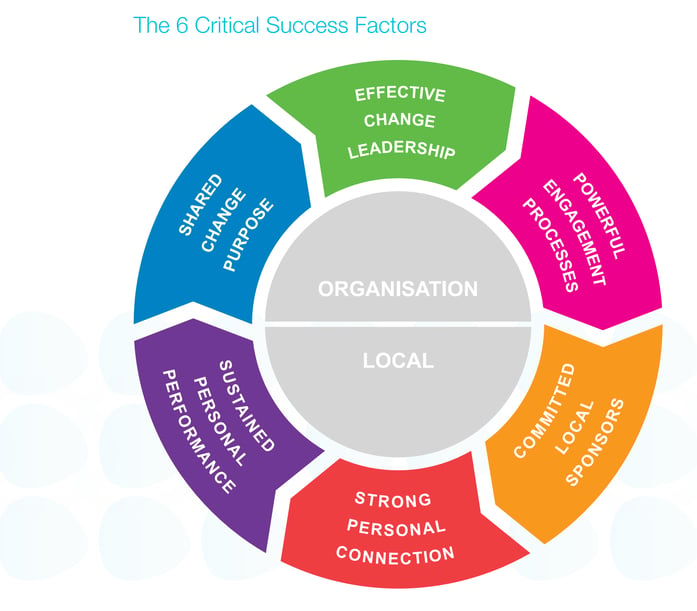
Our world has become one of continuous change. We don’t just expect change, we know that managing change successfully is essential for survival. An adaptable organizational that can stay ahead of the curve and adapt to changes quickly has a competitive advantage in their industry. But for change to take hold it needs to be implemented at the local level, and accepted by the individuals in your organization, and not just strategized in the board room.
Managing change at both the organizational and local level
Last month we discussed that to successfully manage change there needs to be synergy and connectivity between the organizational and the individual.
Successful change implementation is about creating this synergy and connectivity: matching what the company needs with what the people in the organization can accomplish.
To provide that balance we have identified 6 critical success factors (CSFs):
At the organizational level:
- CSF1: Shared Change Purpose: creating and sharing a powerful case for change in the organization
- CSF 2: Effective Change Leadership: Change leadership that provides direction, guidance and support for the change
- CSF 3: Powerful Engagement Processes: which actively engage the organization in the change process.
At the local level:
- CSF 4: Committed Local Sponsors: middle and front-line managers that take responsibility for managing change in their area of authority
- CSF 5: Strong Personal Connection: people across the organization impacted by the change develop a strong personal connection, building personal commitment to the change
- CSF 6: Sustained Personal Performance: those involved with the change are helped and supported through the transition process.
At the organizational level, the success factors relate to the executive leadership, together with the organizational wide framework, that supports and provides direction for the change.
At the local level, the success factors relate to middle and front-line management having the skills and time to help their employees connect and adapt to the change.
Understanding the local structure
The local level structure varies in each organization. It may be geographically spread around the globe, or located in one city. There may be country offices, factories or retail shops. There may be functional teams within market focused teams.

The most important thing to understand is how your organization is structured, and who are the local managers and local influencers who will be driving change on the ground.
By its very nature managing change at the local level is less structured and more personal. For example, it may involve front-line managers coaching people through change or role modelling the changes in behaviour that are needed.
To successfully deliver an organizational change strategy to become more adaptable relies on your local managers to lead this change in their areas of responsibility. Thinking in an agile way, without supporting your local teams and proving your local managers with the tools they need to manage change at a fast pace, will not get you the results you are looking for.
Creating resilience across an organization relies on creating resilient individuals.
In terms of an adaptable organizaton, creating resilience within your teams provides you with the ability to cope with change at a faster pace. Resilient people are not immune to change: they experience the effects just as anyone would, but they recover faster and respond better.
As a result, they tend to be more productive during times of change, and to maintain higher quality output. These individuals come to terms with change much more quickly, and experience much less turbulence throughout the process. In an operating environment that’s increasingly characterised by change, the business benefits of a resilient workforce are considerable.
An organisation with resilient people, as well as systems and processes, is an organisation that can be more agile and proactive. It can adapt to meet the changing needs of its market with more confidence in the results – as well as being able to withstand and bounce back from the effects of unexpected change, whether it’s economic, competitive or environmental.
As with driving any change, creating resilience relies on your local managers having the time and tools to develop this trait within their teams. The skills they learn through this process sets up the foundation and framework for future changes.
Cascading to the local level with the local CSFs
It is the change leader and change agents’ role to cascade change from the organizational to the local level, and help local managers adapt the change to their areas of responsibility. Over the next 3 weeks we will be looking at each of the local success factors in more detail, providing you with guidance and practical tools and approaches to managing change at the local level.



Leave a comment